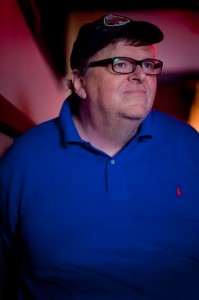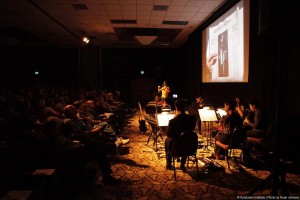Filmmakers should fight the Comcast/Time Warner merger.
As the WGA points out:”Comcast’s proposed merger with Time Warner Cable is bad for everyone:
Filmmakers should fight the Comcast/Time Warner merger.
As the WGA points out:”Comcast’s proposed merger with Time Warner Cable is bad for everyone:
by Andrew Einspruch
Filmmaker Andrew Einspruch attended Screen Forever 2013, the conference of Screen Producers Australia, this past year and wrote a series of articles for the event, which he’s kindly allowing us to reprint here. These articles originally appeared in Screen Hub, the daily online newspaper for Australian film and television professionals.
On a sunny day in Melbourne, where the clouds had clearly been swept away, Kim Wright, Film Producer with the Sesame Workshop, talked about the things that make Sesame Street a success. Screen Hub`s Andrew Einspruch reports from Screen Forever, the Screen Producers Australia conference.
Sesame Street is an amazing success story. Now in its 44th season of 26 episodes each (that`s over 1,100 episodes all up), the perennial favourite of the two-to-five set has kept a loyal fan base of children and former children. It has now been around long enough that some of its original viewers are now grandparents, sharing the show with a third generation.
According to Kim Wright, a key part of the show`s magic of the show is keeping it current. Some of that has to do with the writing, some of it the on-air and off-air talent, and some of it is the ability to adjust its curriculum over time.
And, of course, there`s the comedy and the celebrities. If Bert reads a copy of “Fifty Shades of Oatmeal,” or Usher sings the alphabet, it makes parents want to stay tuned, which keeps the kids tuned in as well.
Wright talked about how the show is developed. Each season starts with a curriculum meeting attended by all the show`s producers and writers (there`s a Head Writer and a team of ten additional writers). There, themes and issues that will be highlighted in the season are discussed. For example, they might be emphasising the idea of self-regulation, which includes things like being patient and controlling emotions. From there, the writers go off to work on scripts that address these themes, and the usual iterative process of writing ensues.
The show is structured in blocks, and each episode is made up of a predictable set of different blocks. For example, there will be a Word on the Street block, a number block, a letter block, a musical number from Elmo, a piece from Cookie Monster in a series called Crumby Films (parodies of current movies), and so on. The show is pieced together over months, with different elements being filmed at different times.
Wright also discussed the film commissioning process. They put out a Request for Pitch (RFP) three times a year. These requests ask filmmakers to come up with ideas for short films that can be included in the show. They can be live action, animation or mixed media. They might be 30 seconds long or a two-minute piece for a music video. There will be two or three films in any episode, and they might be about a letter, a number or something to do with the curriculum. Sesame Workshop basically puts it out there, and it is up to producers to come up with an idea that interests them enough to commission it.
I recently did a long and comprehensive interview with Scott Myers at GoIntoTheStory. We hit a lot of big points. I think you will dig it.
By Reid Rosefelt
Social Media networks go through phases in their lives, just as we do in ours.
Most of us go through periods of adjustment which we handle with varying degrees of success. Many of us don’t climb very high up the ladder of success, and it’s a rare few that become superstars like Justin Timberlake, Jennifer Lawrence, Facebook or Twitter.
Our final excerpt from Jessica Edwards’ new book Tell Me Something: Advice from Documentary Filmmakers comes from Michael Moore:

Here is my advice for those who want to make a documentary film that people will flock to the movie theaters to see:
The first rule of making a documentary is, don’t make a documentary. Make a movie. Nobody wants to see a documentary. To the often-posed question “Hey, honey, what do you wanna do tonight?” nobody responds with “Let’s go see a documentary!” People do, though, want to see a movie. And when they go to the movies, they want to be entertained. I know. I said the E-word. No serious documentary filmmaker would claim to be making something “entertaining,” because that would not only pack the theaters but also diminish the Seriousness and Importance of the Message he or she is trying to impart to the audience.
Well, guess what—nobody wants to sit in a movie theater and feel like he’s being taught a history lesson or preached to or scolded or told he must care about the plight of this or that. People don’t want the invisible wagging finger of the “documentarian” (a word invented for us because we don’t make movies) pointing at them and telling them to take their medicine. That’s why the theatrical audience for documentaries remains so low. It’s Friday night, you’ve worked hard all week, and now you want to relax and go see a movie about … Fracking! Pedophile Priests! My Father Who Deserted Me When I Was 9! Don’t get me wrong—we need to be alarmed about the first two, and the third one, well, I can’t help you with that. I got my own problems.
Last week, I greatly enjoyed my first three days on the job at Fandor– and anticipating all the ones still to come. It’s funny how timing works sometimes… It couldn’t be a better time for me to learn and engage in something new. And it’s remarkable how sometimes somethings end, just as something new begins. Such changes and coordination need so much support, it is a marvel that so much still gets done.
Ten years ago,
By Sheri Candler
Originally published on www.thefilmcollaborative.org
 There is a lot of talk in independent film circles about the need to “eventize” the cinematic experience. The thought is that audiences are increasingly satisfied with viewing films and other video material on their private devices whenever their schedule permits and the need to leave the house to go to a separate place to watch is becoming an outdated notion, especially for younger audiences. But making your work an event that can only be experienced in a live setting is something few creators are exploring at the moment. Sure, some filmmakers and distributors are adding live Q&As with the director or cast, sometimes in person and sometimes via Skype; discussion panels with local organizations are often included with documentary screenings; and sometimes live musical performances are included featuring the musicians on the film’s soundtrack, but what about work that can ONLY be enjoyed as a live experience? Work that will never appear on DVD or digital outlets? Not only is there an artistic reason for creating such work, but there can be a business reason as well.
There is a lot of talk in independent film circles about the need to “eventize” the cinematic experience. The thought is that audiences are increasingly satisfied with viewing films and other video material on their private devices whenever their schedule permits and the need to leave the house to go to a separate place to watch is becoming an outdated notion, especially for younger audiences. But making your work an event that can only be experienced in a live setting is something few creators are exploring at the moment. Sure, some filmmakers and distributors are adding live Q&As with the director or cast, sometimes in person and sometimes via Skype; discussion panels with local organizations are often included with documentary screenings; and sometimes live musical performances are included featuring the musicians on the film’s soundtrack, but what about work that can ONLY be enjoyed as a live experience? Work that will never appear on DVD or digital outlets? Not only is there an artistic reason for creating such work, but there can be a business reason as well.
In reading a New York Times piece entitled “The one filmmaker who doesn’t want a distribution deal” about the Sundance premiere of Sam Green’s live documentary The Measure of All Things, I was curious to find out why a filmmaker would say he never plans for this work to show on streaming outlets like Netflix, only as a live event piece. I contacted Sam Green and he was kind enough to share his thoughts about why he likes creating for and participating with the audience of his work and why the economics of this form could be much more lucrative for documentary filmmakers.